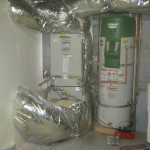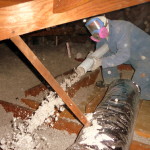What is Home Performance?
Home performance is a comprehensive, whole-house approach to identifying and fixing comfort, energy efficiency, air quality and durability problems in a home. The goal is to identify and prioritize these issues with a home energy audit then find a home performance contractor to address the energy concerns.
An energy audit technician can find the weakest links in your system, and use the data to build a software energy model and suggest the most cost-effective, efficient, and long-lasting upgrades or fixes.
The home energy audit is a thorough inspection of your building envelope, and the effective R-values (thermal resistance) of your insulation, the size and efficiency of your furnace and/or air conditioner, and duct system. The test also examines your energy bill history, and considers factors such as climate, solar orientation, roof overhang, and the age of the home.
There are several tests which can be performed, all requiring certain equipment:
1. The Blower Door tests the rate at which outside air leaks in/out.
2. The Duct leakage test (or DuctBlaster ®), as its name implies, finds leaks in your duct system and measures the total duct leakage as a percentage of total air flow.
3. Thermography, or infrared scanning, is often used in conjunction with the blower door test, and can pinpoint areas of building leakage. It is also used to check the effectiveness of insulation.
4. Other tests performed: Room-to-room heating/cooling air flows, Combustion safety testing, Detailed building measurements, Full top/bottom visual inspection, and various other situational tests.
5. This data is then used to build a software energy model to aid in the formation of energy upgrade prioritization strategies.
Common Problem Areas with Home Performance
A lot of homes have oversized furnaces. These beasts will suck up a lot of energy while heating the building unevenly, cycling on and off, making noise and failing to provide thermal comfort. Upgrading to a properly sized Sealed Combustion Condensing Furnace, or Hydronic Air Handler, can vastly improve energy efficiency and comfort.
Air sealing and proper duct system are often overlooked, but are vital to air quality and efficiency. Even the best furnace or HVAC will accomplish very little if, by the time the conditioned air reaches the rooms, it is mixed with poor quality air from the attic or other areas. The average duct leakage in the state of California is 30% (sadly, this includes newly installed ducts in the average).
Finally, home insulation almost always has room for improvement. There are many different areas of a home where insulation can be added, such as walls, floors, attics, and ducts, and even double paned windows and sealed doors. There are corresponding types of insulation which are most effective in a certain areas, for example, cellulose blown-in, which is effective in walls and attics. The options for insulation can be somewhat overwhelming, as they are numerous and situational. Your energy auditor and home performance contractor can help determine the best options for your home.
Get in contact:
[dropshadowbox align=”none” effect=”lifted-both” width=”640px” height=”” background_color=”#ffffff” border_width=”1″ border_color=”#dddddd” ]If you want to learn more about what Home Performance involves, want to schedule an energy assessment or wish to just ask questions about residential energy, call (925) 363-4498 to speak to a technician. You can also e-mail: info@epbuilders.com[/dropshadowbox]




[…] Energy Audit is a way to use Building Science and Home Performance concepts to perform a comprehensive in-depth testing of a home in order to find out where the […]